Overtourism in Italy: Some hot spots are cutting back but pretty and crowded Cinque Terre isn’t one of them

VERNAZZA, Italy – I stood on the train platform peering up and down the track. I couldn’t find Marina. All I saw were heads and ball caps and backpacks and NBA jerseys and a tour guide with his hand in the warm air. Tourists covered the platform, forming a near total eclipse of the small train station beyond. It was cheek to cheek in more ways than one.
I finally saw Marina as the sea of flesh parted around her small 5-foot-4 figure. She was frantically texting me. She looked pale, a little shaken. Before I could hug her hello she gasped, “I have no word!”
Welcome to Italy in July.

The scene
Travelers? Heed my word: This is the worst time of year to be in Italy. It’s hot. It’s crowded. It’s chaotic. Some places feel more like an Italian theme park than Italy. Last weekend we were in one of those places.
Cinque Terre. The five pastel-colored villages strung along cliffs on the Ligurian Sea in northwest Italy have been famous since the 15th century when the republic of Genoa made it a maritime base. On the to-do list of millions of tourists around the world today is hiking the 7 miles (12 kilometers) from the first village to the last.
Never mind that for years landslides have made two of the villages inaccessible by the traditional picturesque Blue Trail along the coast. Cinque Terre, a UNESCO Heritage Site, still attracts 2.5 million people a year.
What were two savvy Italian travelers like us doing here? I came to visit Helen Richardson, an old Denver Post colleague who came to Cinque Terre with her husband after a sister’s wedding on Lake Como. It was great to see her, catch up on Colorado media industry gossip and for Marina to meet another great photographer.
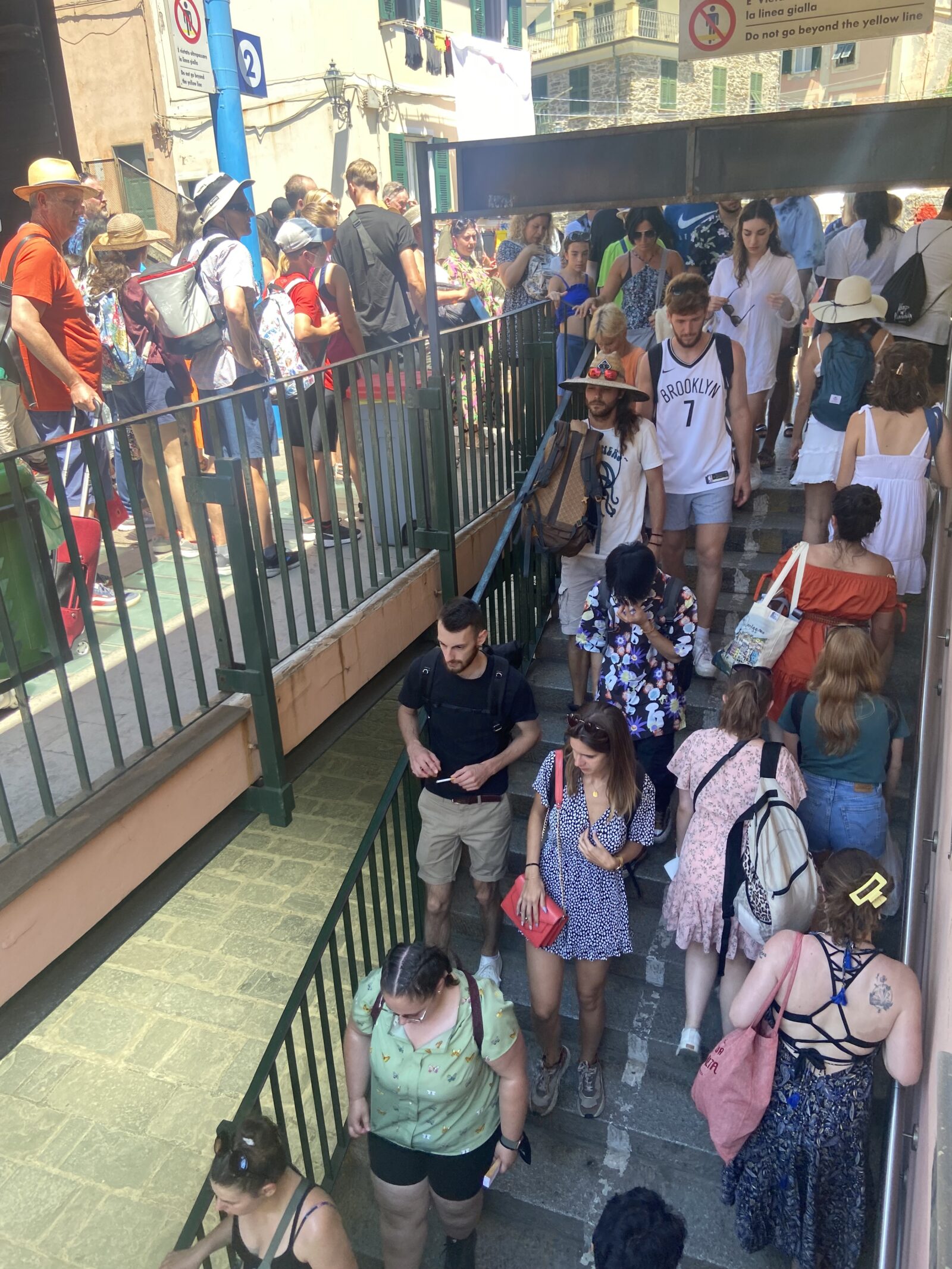
Also, Cinque Terre is worth visiting, particularly this village of Vernazza. It’s home to perhaps the prettiest little harbor in Europe. Its vistas belong in a museum. Plus, the Liguria region is home to Italy’s best pesto. What’s not to like?
Changes around Italy
Well, in July, crowds. In fact, Italy is making up for a two-year Covid tourism slumber. This year Statistica Market Forecast projects tourism will earn the country $17.58 billion. The wave of tourism has made some regions tap the brakes. To wit:
- The Amalfi Coast, which gets about 5 million tourists a year, has instituted an even-odd license plate policy in which your access to the 25-mile (40-kilometer) road route is determined by the last number on your license plate.
- Venice, which gets 20 million a year, recently announced that starting in January it will charge each visitor who’s not a resident 10 euros to enter the city.
- Many beaches on the Sardinian archipelago of Maddalena are off limits.
- On mainland Sardinia, La Pelosa beach in Stintino, maybe my favorite beach in Italy, is allowing only 1,500 visitors a day and charging 3.50 euros.
- Rome is requiring reservations to visit the Pantheon, our 2,000-year-old temple, on weekends although it’s still free.

In 2016, Cinque Terre wanted to limit the number of visitors to 1.5 million a year but that fell through. In 2019, Fabrizia Pecunia, the mayor of the villages of Riomaggiore and Manarola, again sought a limit. Then Covid hit. Problem solved although a painful one.
As modest fishing villages, the five towns of Monterosso, Vernazza, Corniglia, Manarola and Riomaggiore were once primarily accessible by sea. Now every 30 minutes a local train runs through the towns like an Erector set, disgorging hundreds of tourists either making day trips or looking for the trailhead.
As my train to Vernazza stopped at Manarola, I saw a bottleneck of tourists trying to squeeze down the platform stairs to the village below. The line was 30 feet long.

Part of the problem is Cinque Terre is so easily accessible. I took a 3 ½-hour train ride from Rome to La Spezia, Italy’s largest naval port town, just nine miles south of Cinque Terre. The local train took 18 minutes to reach Vernazza.
Marina, a hardened Roman not easily impressed, calls Vernazza a tourist trap. It is not. A tourist trap is a place that does not merit its interest. The Taj Mahal, the most beautiful building in the world, is not a tourist trap. The Great Pyramids, one of mankind’s architectural marvels, is not a tourist trap.
Cancun, Mexico’s giant vomitorium, is a tourist trap. Graceland, where you can get an Elvis Blue Hawaii Tiki Mug for $25, is a tourist trap. Rome’s La Bocca della Verita’, where thousands stand in line to photograph themselves putting their arm inside a mouth carved into a marble disk (it’s said if you tell a lie the mouth bites off your arm) is a tourist trap.
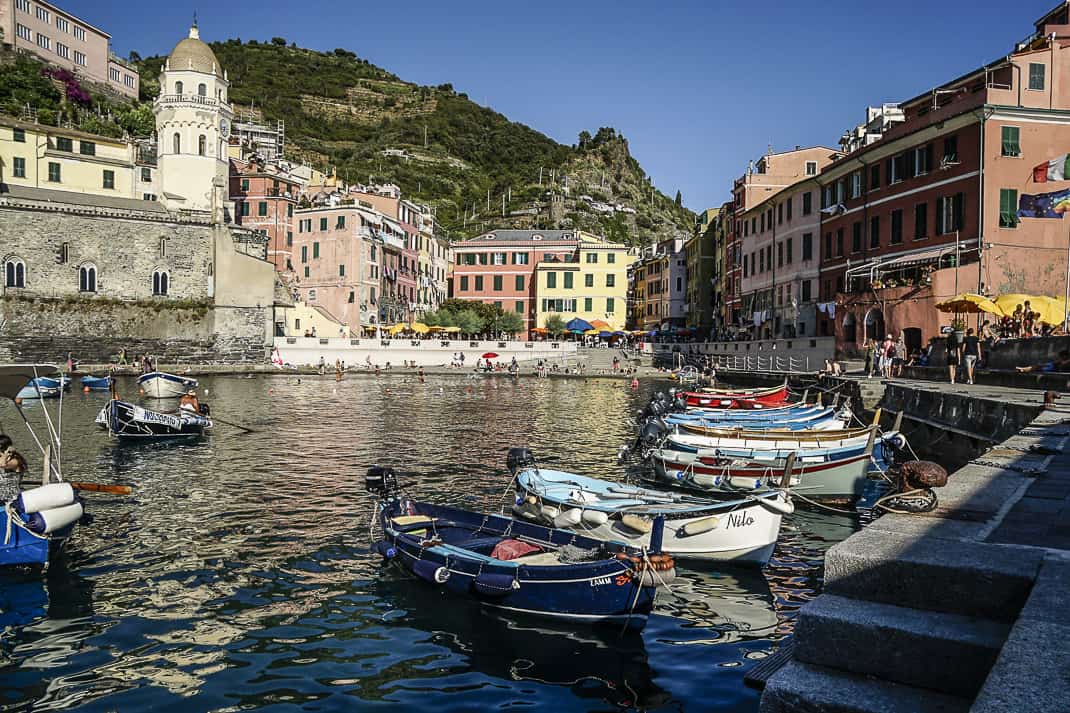
Why they come
There’s a reason millions have flocked to Vernazza. It’s beautiful. Descend down from Monterosso (or climb a short ways from Vernazza’s harbor) and look at the pastel buildings encircling the little harbor with boats bobbing in the clear blue water. It looks painted by Van Gogh.
Add pesto, the luscious pine nut sauce, on everything from fish to pasta to focaccia and Liguria’s crisp Pigato white wine, and you have a storybook Italian vacation.
I’d been here twice before and seen Vernazza’s other side. The first came in the winter about 15 years ago when I arrived at night during a wicked rainstorm. Everything had shut down. I stood on the harbor and threw a pebble at the window of a sleeping woman who had the lone open room. I spent the evening at a tiny, corner bar talking to local fishermen. I loved it. It was quiet insight into the soft underbelly of a massive tourist destination.
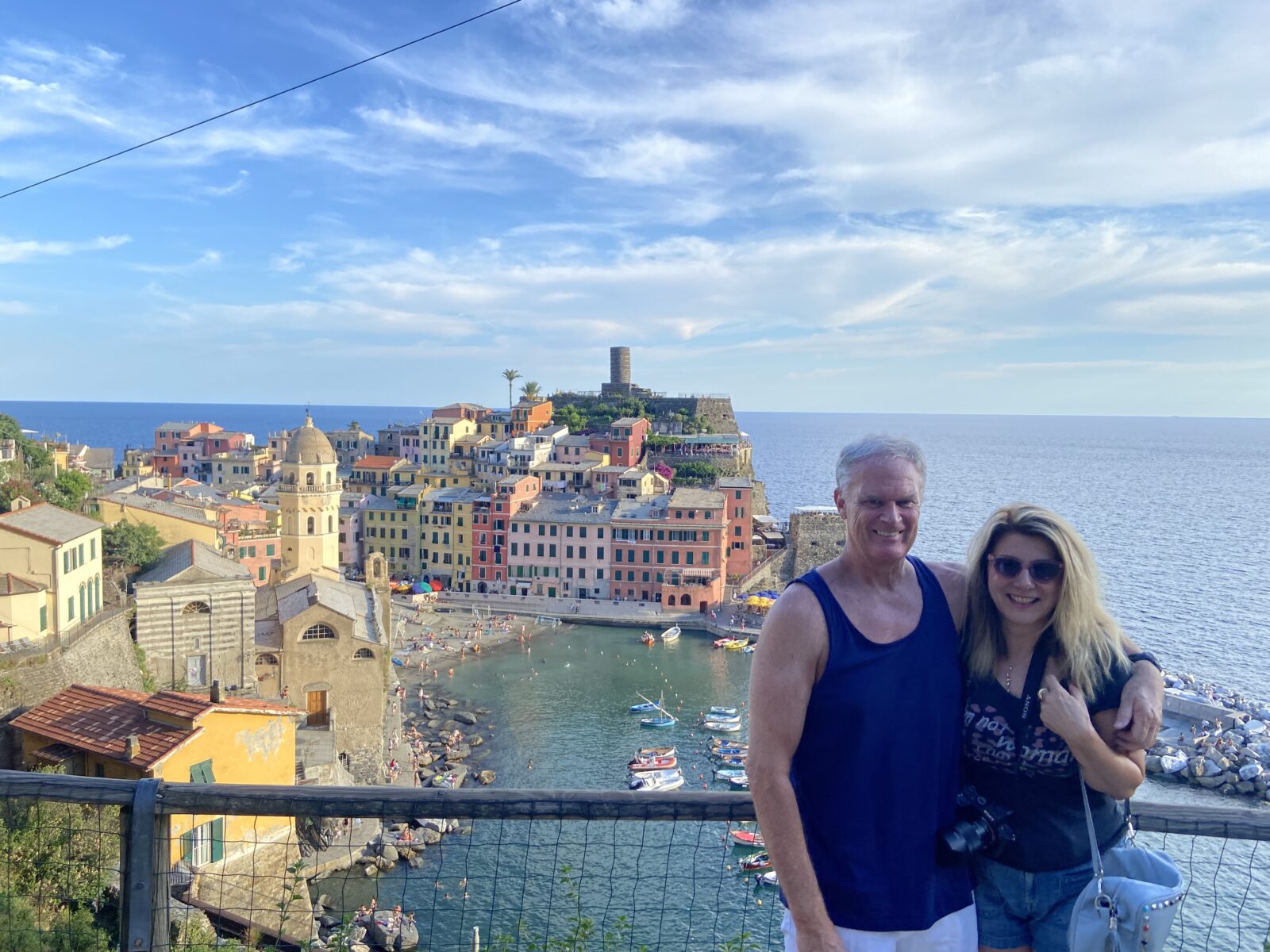
In 2014 I came in May and the trail felt like Interstate 405 during an evacuation. Or picture the DMV with better views. However, after the hikers and day trippers left, Vernazza at night was quiet and uncrowded. Dinner on the harbor was one of my best experiences in Italy.
In July it’s like being on a Hollywood movie set with 5,000 extras. I haven’t heard this much English since my last Denver Broncos game. And American tourists still don’t know how to dress. In a random five-minute stretch I saw NBA jerseys of the Hawks, Timberwolves, Nets, Thunder, Jazz, Lakers and Rockets. I saw more white fedoras than in a Panama hat factory.
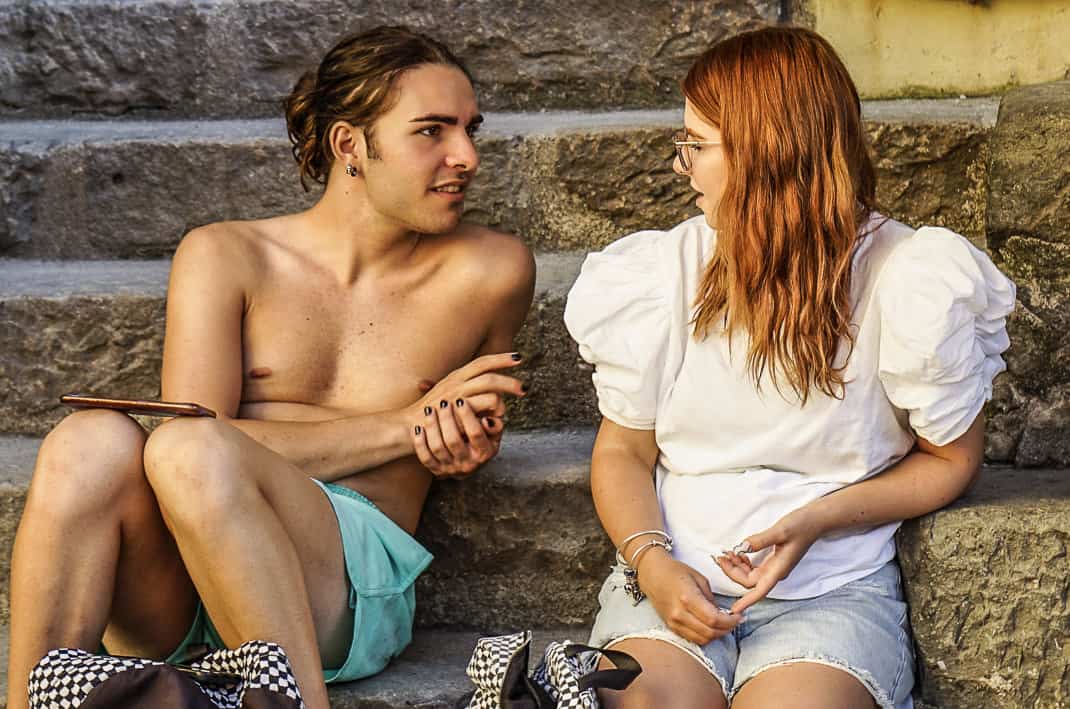
I looked at my upcoming hike to Corniglia with the enthusiasm I reserve for paying my electric bill at Rome’s post office. If it looked like the DMV in May ,,, in July? After Covid canceled trips for two years?
I expected I’d have to take a number.
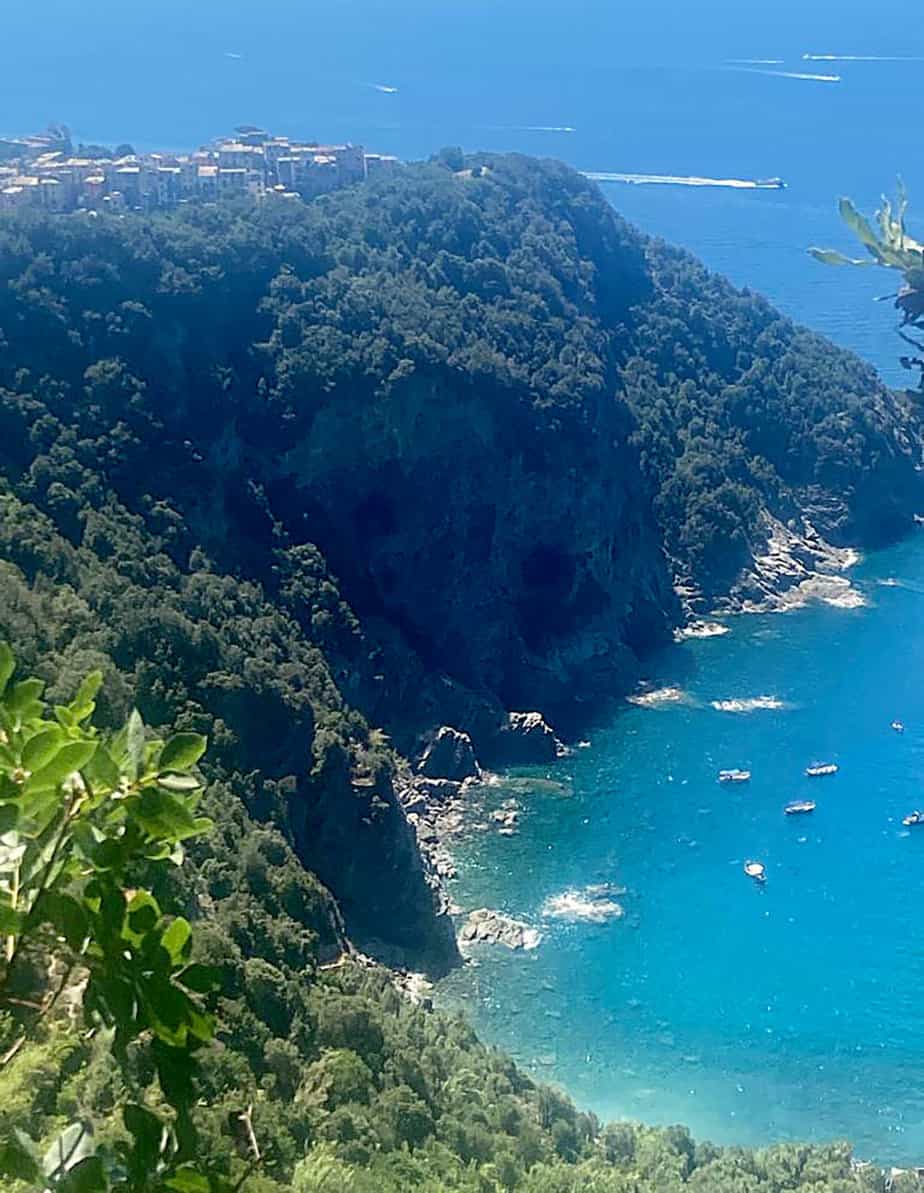
The hike
I wanted the full effect of the overtourism so I waited until 10:20 a.m. to begin. At 8 I went to Ananasso Bar on the harbor for a cappuccino. The outdoor tables were empty. By 8:30 nearly every table was filled. I heard German, Swedish, American English of course.
The trail from Vernazza begins on a tiny stone pathway next to the pharmacy. I climbed past some B&Bs and walls of purple bougainvilleas. I kept climbing. I kept waiting.
Where were the other hikers?
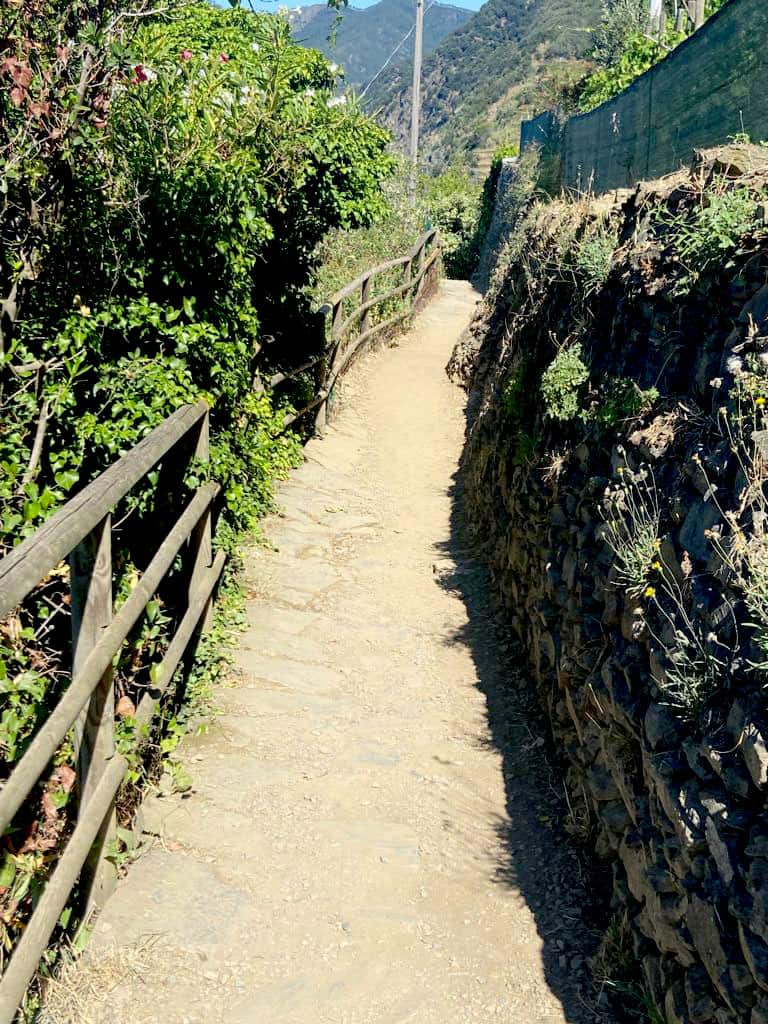
In 10 minutes I had reached a lookout with a beautiful vista of the town below. I had seen only 10 other people. I was alone. At each town there is a ticket booth where you must show a Cinque Terre Card you buy for 7.50 at the train station. It had no line.
“Not many people here today,” I said to the bored ticket taker.
“It’s early,” she said. “Many people will come by train.”
I looked at my watch. It was 10:30, prime time for hiking. I was beating the heat.
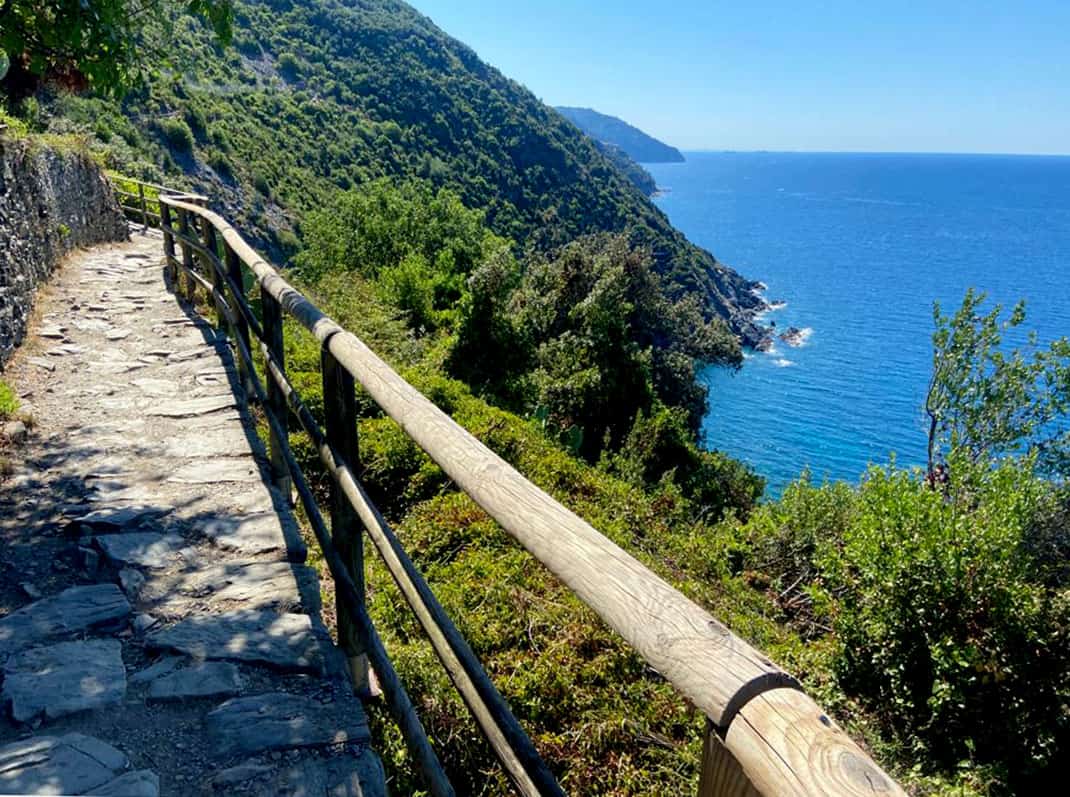
The trail continued upward without respite. But the hike is anything but laborious. Around every turn along the coast there’s a new view of Vernazza and the Ligurian Sea below. After 30 minutes of hiking one of the premier trails in Europe, in July, I’d seen only about 15 people.
I heard crickets in the trees. I heard seagulls squawking above. I heard the waves below. My pending nightmare was turning into one of my highlights in 8 ½ years retired in Rome.
The trail continued upward. So few people passed that I made a point to say “Ciao!” or “Buongiorno!” to everyone. They did the same.
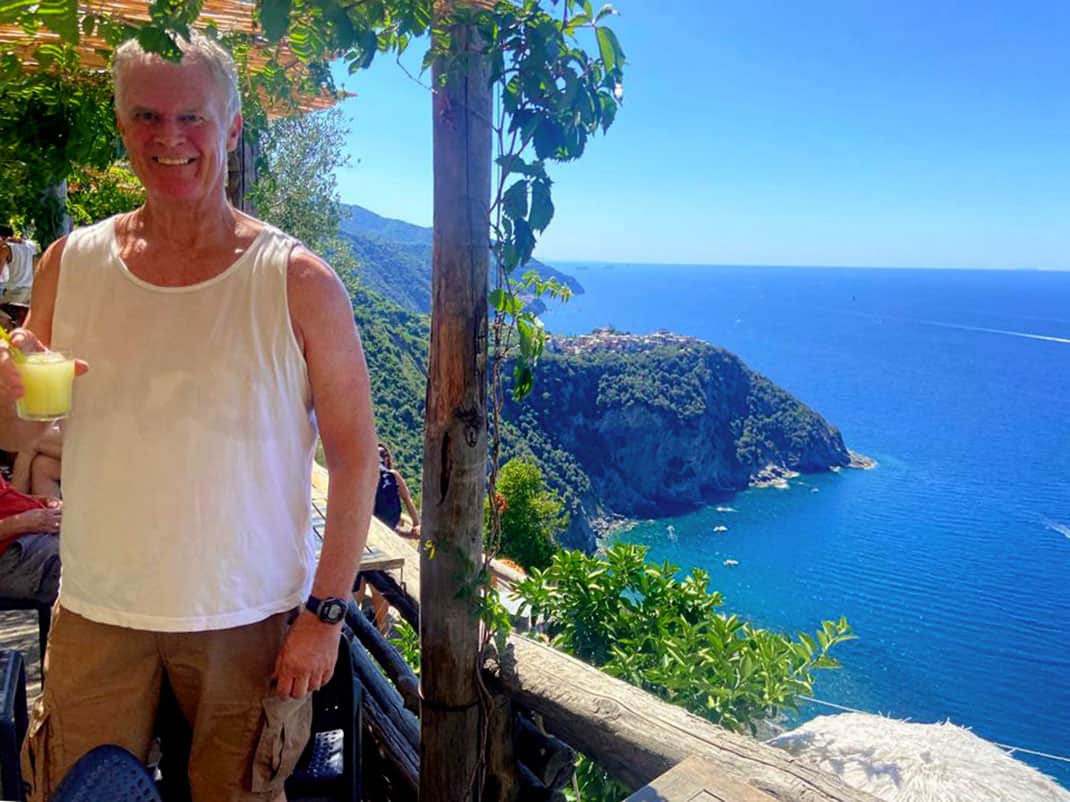
At 220 meters above sea level, the highest point on the Vernazza-Corniglia leg, I came across a bar with one of the best views in Italy. Il Gabbiano Bar consists of only half a dozen outdoor tables on a terrace overlooking the sea. The sign says to order drinks from the bar 30 meters down the hill with the tip, “Send the person with the strongest legs.”
I walked in the bar and two hikers had commandeered one inside table. Two others ordered drinks ahead of me. I ordered a lemon slushy with orange juice and asked the friendly, young bartender where the crowds were.
“Troppo caldo! (Too hot!),” he said. “In September it will be crazy. Two months ago, it was crazy.”
Too hot? I looked at my phone’s thermometer. It was 75. A cool breeze came up from the sea. I don’t even remember sweating much. Vernazza’s forecast for that weekend didn’t top 79. I could not have had better hiking weather if I was inside a Hilton.
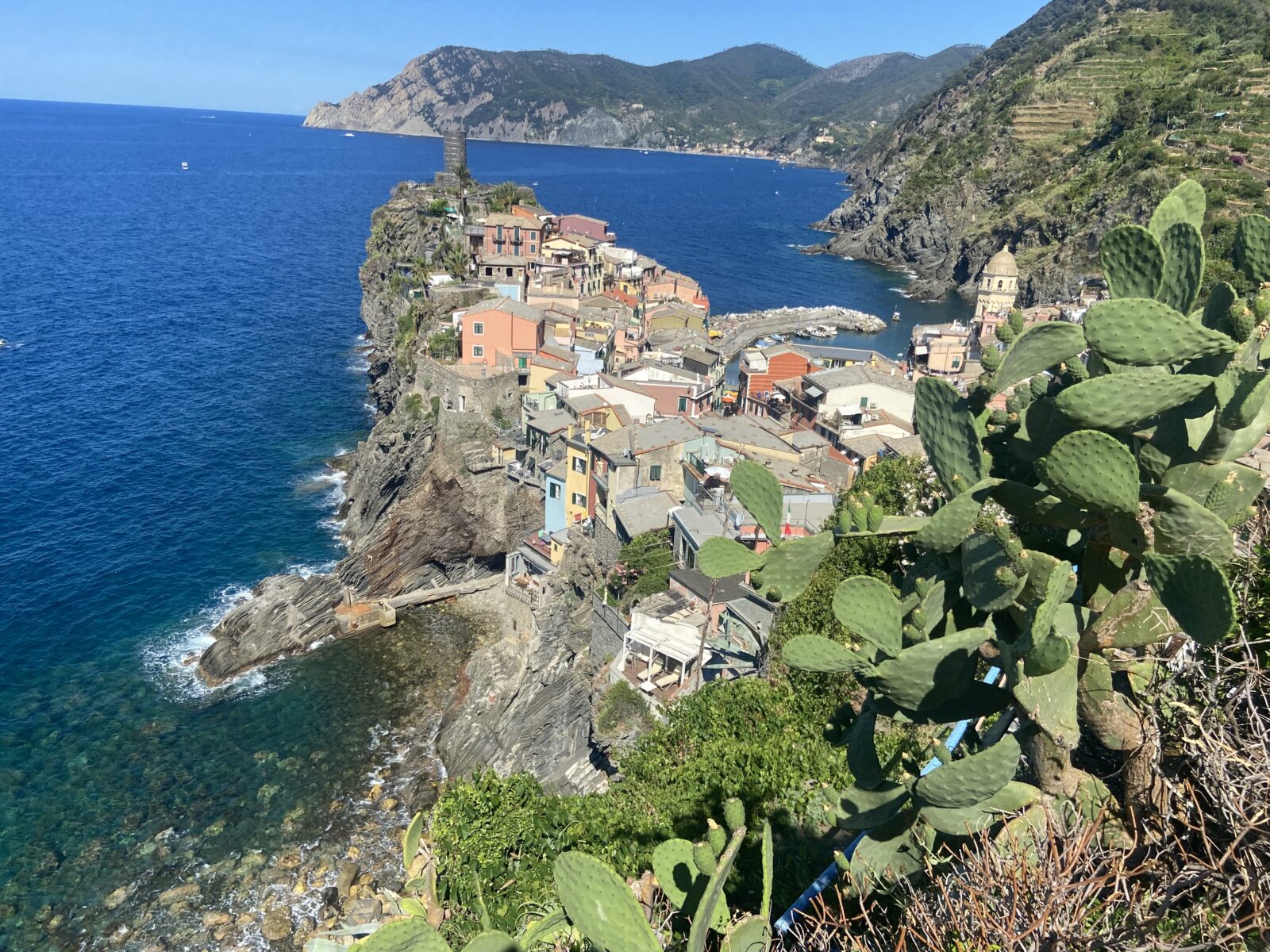
I asked him about the false news I read that Cinque Terre had limited the number of hikers.
“During Covid, everyone complained: ‘NO TOURISTS! NO TOURISTS!’” he said. “Now tourists are back and it’s, “TOO MANY TOURISTS! TOO MANY TOURISTS!”
I returned to the quiet terrace and nursed my sweet slushy with a couple from Arizona and two women from Oregon, my home state. We probably felt like we’d never left the States except nothing in the U.S. has our view: Looking 700 feet down to a sea in three shades of blue with purple bougainvilleas lining the path leading to little Corniglia perched on a distant cliff sticking into the sea.
I started my descent to Corniglia but quickly stopped to write down more notes, words that couldn’t possibly capture what I saw.
“Poetry in motion, isn’t it?” said a voice nearby.
A middle-aged British man and a young woman were two of the few I saw on this remarkable lookout point. The day before, he said he had taken an even lighter-troddened route. The 508 route, part of 74 miles of hiking trails in Cinque Terre, leaves Vernazza away from the coast straight up even higher, an elevation gain of 485 meters, to Force Drignana, home of a very lonely monastery and monumental views.
It’s part of the route you can take to circumvent the landslides and reach Manarola and Riomaggiore.
“But the climb is relentless,” he said. “It never stops. I was absolutely knackered.”
I wasn’t. I practically skipped down the hill to Corniglia where I took an outdoor, shaded table at Ristorante Dau Tinola and had a plate of trenette alle pesto, Liguria’s long, flat, ribbon-like pasta. Over my cold beer I could see the adjoining streets, one leading to the train station and the other leading to the town center.
It was bottlenecked. Dozens of people struggled to move.
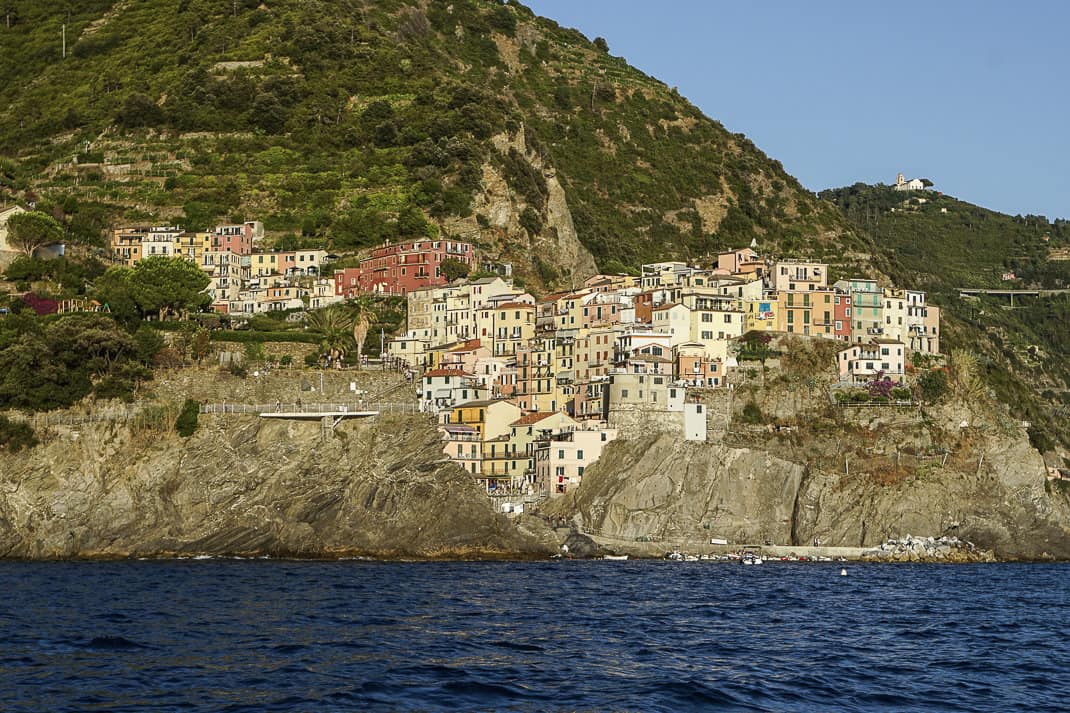
Boat cruise
To get away from the crowds, Marina and I spent our last night taking a 2 ½-hour sunset boat cruise that went by all five villages. From the sea, each town has a different look. The boat captain explained to the 10 of us that the buildings are uniquely pastel colored so incoming boats can tell what port to enter.
The cruise was lovely, accentuated by a dip in an 81-degree sea, Prosecco and five minutes of silence as we watched the sun set behind the cliffs dividing Vernazza and Monterosso.
But when we returned to port at 9 p.m. the crowds hadn’t thinned much. The total number of people the relentless mob bothered appeared to be only two: Marina and me.
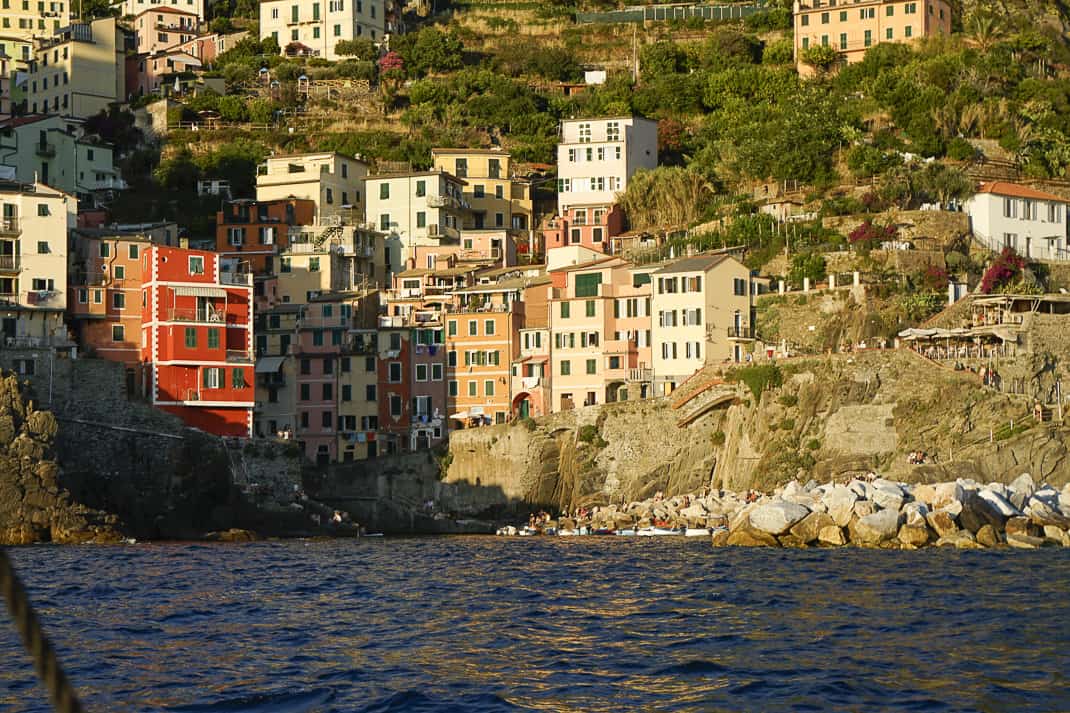
Tourists knew what they were getting into; merchants liked what they were getting. Cinque Terre is not like Venice where Venetians rose up and demanded the city government establish limits.
Thanks to Helen’s suggestion, Marina and I became regulars at Il Pirata, a Sicilian-style restaurant at the edge of town where the Cutropia twins served up Western-style eggs and nine different kinds of cornettos. They were also the best comedy act in town. When I saw Massimo and Gianluca and asked if they were twins, Gianluca said, “Yes. I’m the brother. He’s the sister.”
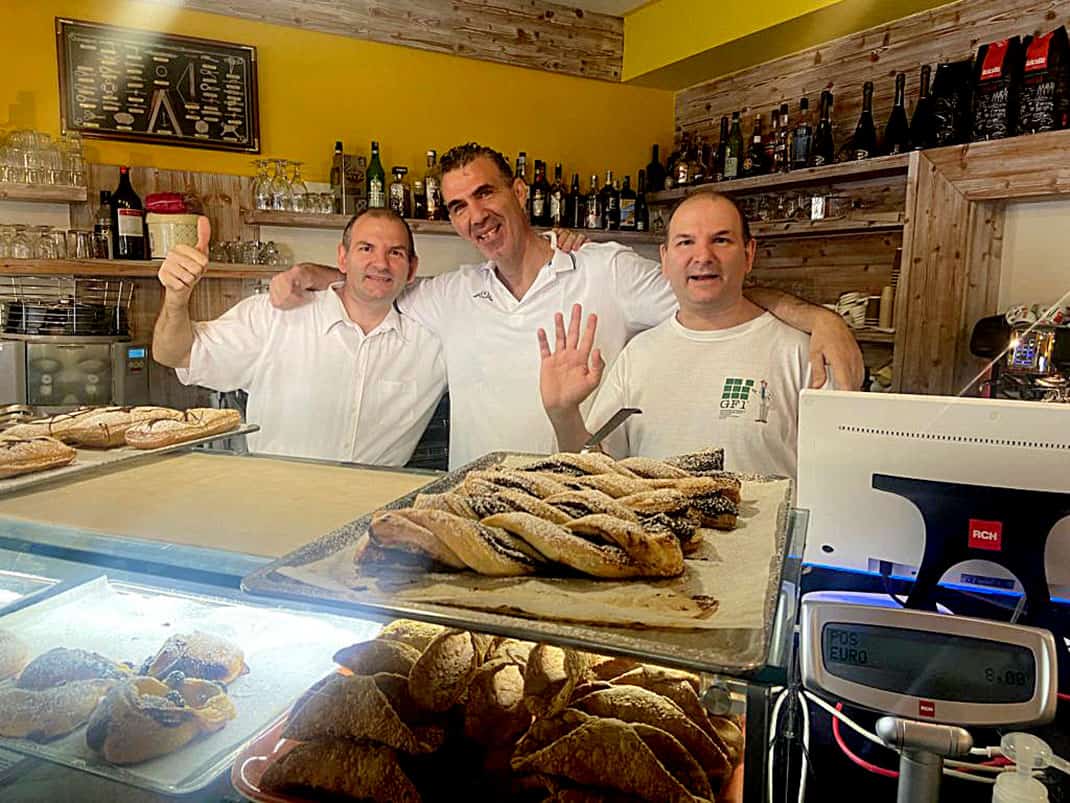
Seriously, to them and business owners like them, the talk of over tourism is just that. Talk. Too much talk.
“Before Covid, there were too many tourists,” Massimo said. “But no. It’s normal. Everyone wants to see this place. It’s good for everybody. Everyone can work.”
The mayor
But when does tourism cross the line from supporting a population to ruining the atmosphere? Vernazza crosses the line in July. I felt claustrophobic at times, although the small sandy beach and stone boardwalks offer plenty of entry points to swim in solitude.
I needed to know from the top. I called Mayor Francesco Villa who was kind enough to meet us on a shady bench in the main Piazza Marconi. Villa was born, raised, educated and employed in Vernazza. Cinque Terre’s former chief of police has been mayor since 2019 and says more than 90 percent of Vernazza’s economy comes from tourism.
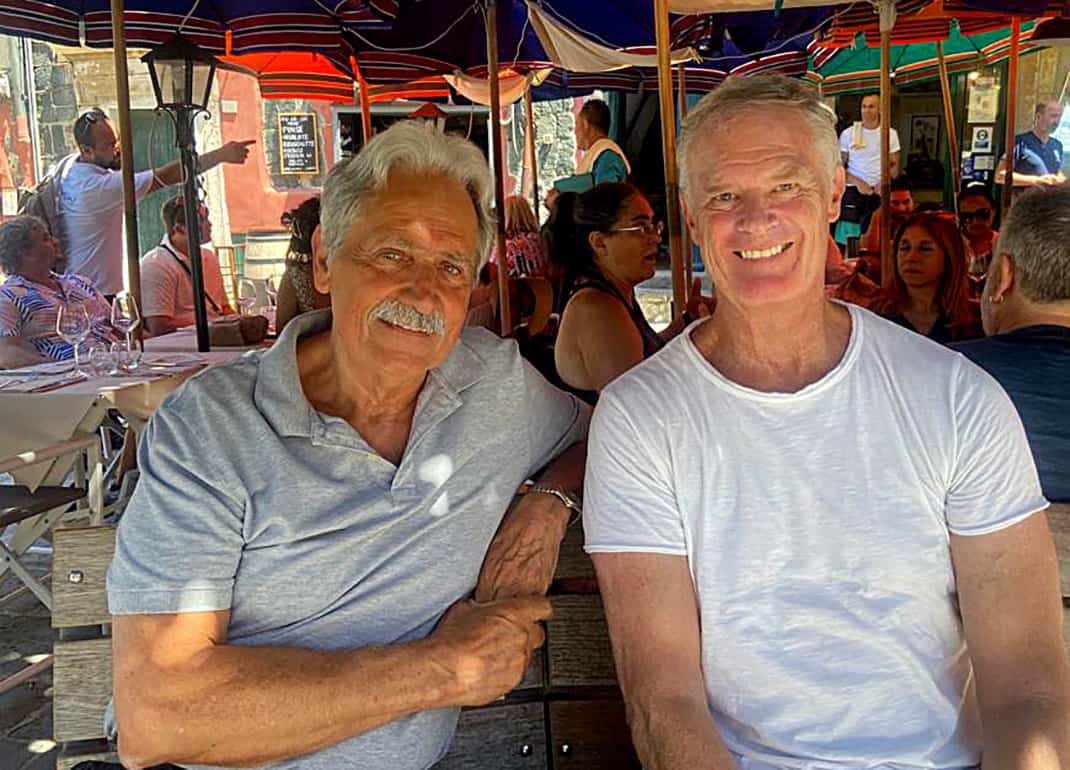
It’s why he never considered limits on visitors.
“I don’t worry about too many tourists because of the good things it does for the economy,” he said in Italian. “We are 500 people. Many tourists here are OK, not only for local people but for every service in Vernazza like hotels, B&Bs, bars, restaurants and shops.”
He said putting limits on tourism can backfire.
“I don’t want to limit the influx of hikers because if I block hikers here, in the future we’ll have a problem,” he said. “I know if tourists call Cinque Terre and Cinque Terre says, ‘No, don’t come here,’ it means they won’t come here anymore. Tourists are very sensitive.”
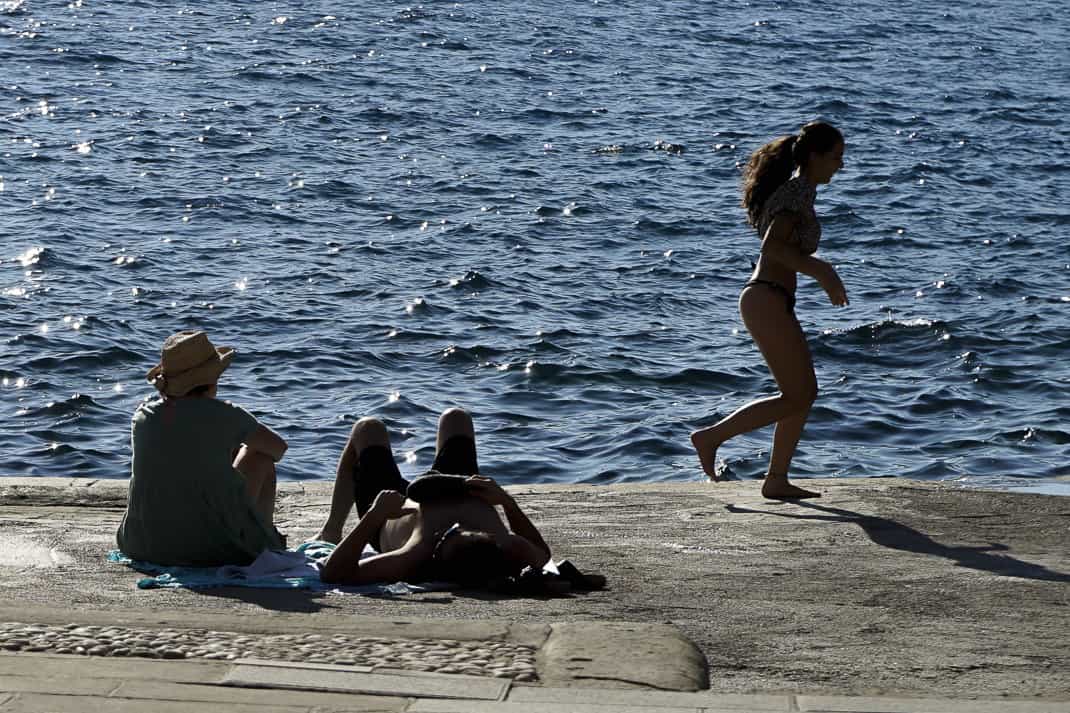
Vernazza also gets a high-quality tourist. I found one bar: Burgus, in the same space where I drank with the fishermen 15 years ago. Drunks in Vernazza are few; fights are non-existent. But package tourists are not.
“I want to be better with groups like 50 tourists and big families,” the mayor said. “If they’re not organized, they block the streets and activities. The single person who comes here and the single person with a family I have no problem.”
On Monday, after three nights and four days, I squeezed my way onto a packed train with Marina back to La Spezia and onto Rome. She looked ready to collapse.
“The place is beautiful but too many tourists,” she said. “I’m Italian. Since I was a baby I’ve lived with tourists. All over Rome. I’m tired. In Vernazza I can’t feel the Italian tradition or the Italian mood.”
Italy is open for business again, folks. Just don’t come now.
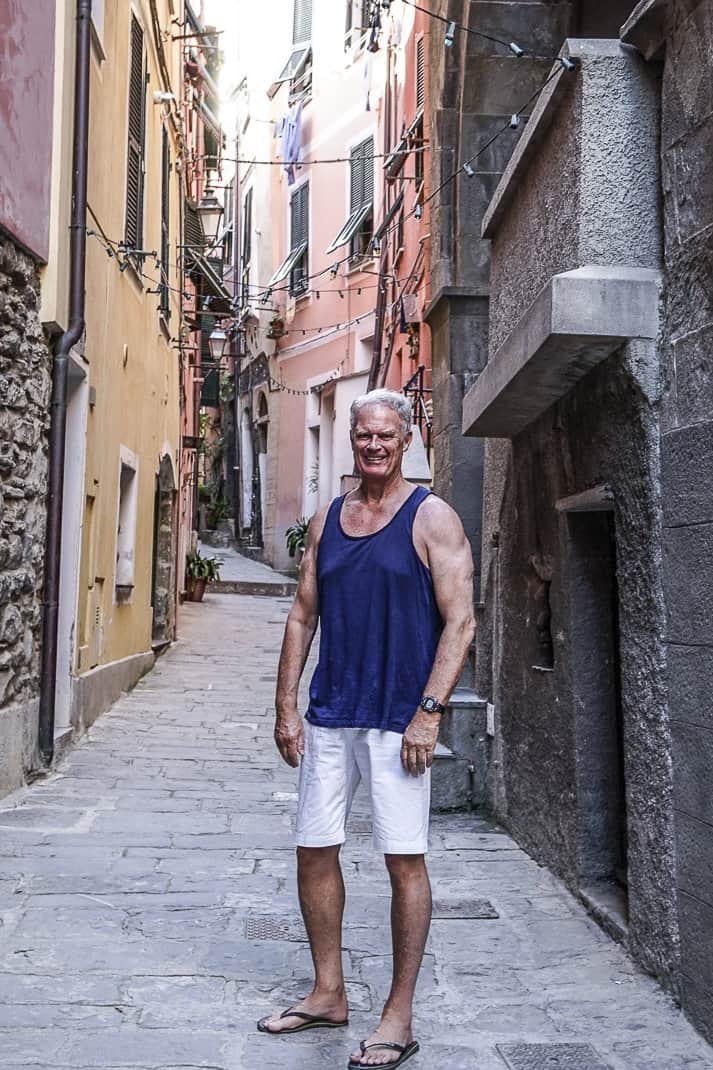
Do you want to go?
How do you get there? Fly into Pisa and take the train from the Pisa airport to La Spezia. The 90-minute trip starts at 13 euros. Then connect to a train for Riomaggiore — or any of the other four villages — for 5 euros. The trip to Riomaggiore is eight minutes. La Spezia is 3 1/2 hours by train from Rome and Milan. Do not drive. Parking is nearly impossible.
Where do you stay? Taverna del Capitano, Piazza Marconi 21, 39-01-87-812-201, www.tavernavernazza.com, info@tavernavernazza.com. Excellent restaurant on the main piazza has three double rooms and two apartments that hold six people each. They’re located around the corner on Via Roma. I paid 297 euros for three nights in a spacious room with a fan. Although we climbed 60 steps to our room. Apartments are 200 euros.
Where do you eat? Taverna del Capitano, 7 a.m.-10:30 p.m.; Monday 7 a.m.-4 p.m., 7-10 p.m. Paolo, our hotel owner, also had the best food on our trip. Excellent fresh seafood such as tuna in sesame seeds and grilled orata (sea bream) starting at 20 euros.
Il Baretto, Via Roma 31, 39-0187-812-381, www.il-baretto.it, noon-10 p.m. Tuesday-Sunday. Excellent local Ligurian cuisine, starting at 9 euros. Try the traditional trofie with pesto.
When do you go? As I wrote, avoid July and August, not for the weather but the crowds. Cinque Terre is actually quite temperate. It rarely hits mid-80s in summer and lows drop to high 60s. A cool breeze off the sea is often present. Ideal month is September when sea remains warm and air temperatures range from 77-62. However, September and May are peak hiking seasons.
Need more information? Parco Nazionale, www.parconazionale5terre, 8 a.m.-8 p.m. summer; 8:30 a.m.-noon, 1-5:30 p.m. winter. Has offices in train stations of all five villages and in La Spezia. Also try www.cinqueterre.it and www.cinqueterre.com.


July 13, 2022 @ 1:01 pm
Brilliant John! This is such a beautiful corner of Italy and your advise will make the trip even more enjoyable for many people.
July 13, 2022 @ 1:12 pm
Sky high accommodation £2€ – even with a weak euro at a rough estimate a third higher over the last several of months. What are the on the street costs – local supermarket prices in Rome? Despite all the odds its got to be Monti in August can not wait to get there.
July 13, 2022 @ 8:34 pm
What a great idea to take a boat cruise with only eight other people to escape the maddening crowds for a few hours. Watching the sun set off the coast of the Cinque Terre with a glass of prosecco-pure bliss!
July 13, 2022 @ 9:28 pm
I am so glad I went there in 1980s and 1990s. In the early 2000s it shot to stratospheric popularity and I was, at the time, living in Florence and running a destination wedding business. I refused to organize weddings in the Cinque Terre because those villages were already over-run. Like you John, I decided to talk to the mayor of Vernazza to get his take. (Yes back then the mayor was “he” as well. Have to qualify that, because I don’t unconsciously use “he”by default– when people do that it drives me nuts.)
Anyway, it was 2003. He lamented that the villages were losing their culture. He said that no one wanted to work the land anymore (the famous terraces on the mountain sides) because they wanted to make a fast buck on tourism. Understandable, but it does mean that certain aspects of traditional culture are lost. I recount this in my book Return to Glow, A Pilgrimage of Transformation in Italy. 😉
I would still go there absolute off-season but you cannot convince me to go there in the summer.
July 27, 2022 @ 4:47 pm
Get in the water is my advice. Just visited each of those beautiful ports, Capri, Amalfi Coast, Rome, Venice, and Pompeii. Hiking is a must to see the vista’s. Swimming is a must to survive. Buy a large water at a local shop off the main streets and refill it every chance you get. Most trails have potable water faucets and they’re available in Pompeii too.
But really…get in the water. It cools you down, is less crowded, and allows you to see the beauty from a less stressful perspective.
Also…take a small day pack with a change of clothes. Play during the day, shower, enjoy the evening.
July 14, 2022 @ 5:02 am
John:
For the most part, I enjoy your blog. However, it is contradictory of you to continually take jabs and make sweeping generalizations towards Americans. The pot calling the kettle black. Yes, there are Americans that wear sports jerseys. Yes, there are Americans that decide to purchase a hat. Yes, there are overweight Americans too. Yet, here is John, this seventy something guy with man breast, wearing a cheap tank top. See where I am going? Those who live in glass houses should not throw stones. But at least you wore a “shirt” when meeting Mayor Villa. Best!
July 14, 2022 @ 5:02 am
John:
For the most part, I enjoy your blog. However, it is contradictory of you to continually take jabs and make sweeping generalizations towards Americans. The pot calling the kettle black. Yes, there are Americans that wear sports jerseys. Yes, there are Americans that decide to purchase a hat. Yes, there are overweight Americans too. Yet, here is John, this seventy something guy with man breast, wearing a cheap tank top. See where I am going? Those who live in glass houses should not throw stones. But at least you wore a “shirt” when meeting Mayor Villa. Best!
July 14, 2022 @ 5:03 am
John:
For the most part, I enjoy your blog. However, it is contradictory of you to continually take jabs and make sweeping generalizations towards Americans. The pot calling the kettle black. Yes, there are Americans that wear sports jerseys. Yes, there are Americans that decide to purchase a hat. Yes, there are overweight Americans too. Yet, here is John, this seventy something guy with man breast, wearing a cheap tank top. See where I am going? Those who live in glass houses should not throw stones. But at least you wore a “shirt” when meeting Mayor Villa. Best!
July 14, 2022 @ 8:56 pm
We stayed just north of Cinque Terre in Levanto for our October 2017 visit. Quiet, peaceful, reasonable prices, beautiful sunsets, and easy access to Cinque Terre by train.
July 14, 2022 @ 10:47 pm
Like they say in France, never argue color or taste…j’espere!
Thanks for the article!
July 20, 2022 @ 2:46 pm
I stayed in Vernazza for 3 days in May 2019 with my then 19 year old niece. We got off the train at 11 am and couldn’t move. Took the train to Corniglia so we could hike to Manarola. The trail was wonderful. When we got back to vernazza all the day trippers were gone and it was amazing-we had the place to ourselves. Same with the next morning. By the time the day trippers got off the train, we were hiking to Monterosso. We had a great time, but would definitely not recommend going as a day trip, no matter what time of year. You need to be there in the evening and morning to really see the Cinque Terre. The day we left it started pouring rain for a week straight. We were lucky, as there are no indoor things to do there. Ciao, Cristina
July 25, 2022 @ 9:36 pm
Loved your information! Interest in your sunset cruise. Please give info on what cruise you took. Thank you!
July 26, 2022 @ 8:27 am
Just got back from a vaca in Riomaggiore. Our Airbnb hosts were the sweetest people: picking us up at trsin station in La Spezia when our train was delayed. Then our key broke off in the lock, and they stayed all day with our possessions until it could be repaired. Yes. It is over-touristed, but not as bad as described. Highly recommend Antonio with crazyboattours for a sunset cruise.
Also, as a rule American s are NOT the ones in their sports jerseys or town names like NY, Miami, etc. Those are European tourists who are proud to have visited the states.
July 26, 2022 @ 11:16 pm
My husband, son, and I were there in early July, and we must have been lucky with our dates because it was not crowded. We we’re never in a mob of people even at the train station. We stayed in Monterosso but visited the other towns. We also enjoyed peaceful hiking with only a few others on the trails, loved Monterosso to Vernazza trail. And we saw a lovely summer opera in Vernazza with maybe 20 people in attendance. Everyone was friendly and enjoying a leisurely pace. It was magical.
July 30, 2022 @ 9:07 pm
I agree with the part of the crowds in Cinque Terre right now and obviously, its hot in the summer.
I was turned off with the authors complimenting himself as a “savvy travy” and a “excellent photographer”. Put a bad taste in my mouth.
Also, why is it so popular to insult Americans tourists these days? We’ve all heard it ad-nauseam. Some day we’ll zip up our wallets and Europeans won’t have to deal with it any longer.
July 31, 2022 @ 6:22 am
Where did I call myself a “savvy travy”? I’ve never even heard that term.
July 31, 2022 @ 4:06 am
Interesting, but no male, other than an Olympian, should be in a tank top. That screamed “ugly American.” So then, it makes me suspect of the information.